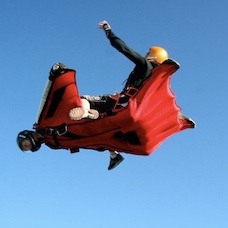Recommended Posts
ficus 0
QuoteYou would rather have them fly straight into power lines than flat turn and land parallel?
If they flat turn and land parallel, they have satisfied the #1 priority, which is a straight and level wing. If they are unable to land with a canopy over their head, I would rather they fly straight into power lines than land in a turn.
I agree that obstacle avoidance starts much higher than 100 feet.
tdog 0
I teach the landing priorities from the USPA SIM
1) Wings level
2) Open area
3) Flare
4) PLF
I point out that LANDING INTO THE WIND IS NOT ON THE LIST.
To illustrate the point, and importance of #1 - which is the number one way to kill yourself in skydiving these days it seems, I ask the class:
1) Have you ever wiped out on a snowboard, rollerblades, or bike going 20 MPH and tumbled? How seriously were you hurt?
2) Have you ever jumped from the window of the 3rd floor of an apartment building without a rope? How seriously were you hurt?
I then say simply: "Don't die trying to land into the wind."
The culture of landing into the wind is too strong in a lot of instructor's and experienced skydivers mind. There is a reason it is not on the USPA SIM landing priorities.... BECAUSE IT IS NOT A PRIORITY.
1) Wings level
2) Open area
3) Flare
4) PLF
I point out that LANDING INTO THE WIND IS NOT ON THE LIST.
To illustrate the point, and importance of #1 - which is the number one way to kill yourself in skydiving these days it seems, I ask the class:
1) Have you ever wiped out on a snowboard, rollerblades, or bike going 20 MPH and tumbled? How seriously were you hurt?
2) Have you ever jumped from the window of the 3rd floor of an apartment building without a rope? How seriously were you hurt?
I then say simply: "Don't die trying to land into the wind."
The culture of landing into the wind is too strong in a lot of instructor's and experienced skydivers mind. There is a reason it is not on the USPA SIM landing priorities.... BECAUSE IT IS NOT A PRIORITY.
Hear! Hear!
My reality and yours are quite different.
I think we're all Bozos on this bus.
Falcon5232, SCS8170, SCSA353, POPS9398, DS239
I think we're all Bozos on this bus.
Falcon5232, SCS8170, SCSA353, POPS9398, DS239
jacketsdb23 45
Thanks tdog! I agree!
Losers make excuses, Winners make it happen
God is Good
Beer is Great
Swoopers are crazy.
God is Good
Beer is Great
Swoopers are crazy.




It is about decision making while you have plenty of altitude
We also teach flat turns close to the ground, full toggle turns up high
You would rather have them fly straight into power lines than flat turn and land parallel?
Share this post
Link to post
Share on other sites